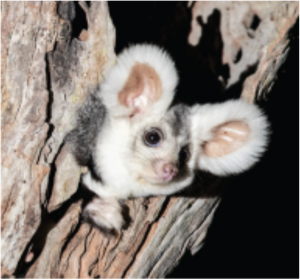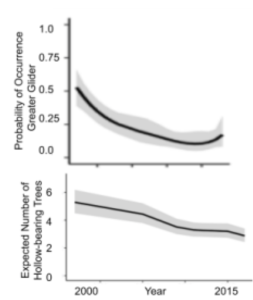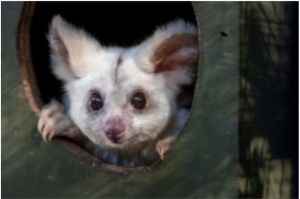By Adam Vera, Applied Chemistry ’23
 The greater glider (Petauroides volans) in a hollow-bearing Eucalyptus tree
The greater glider (Petauroides volans) in a hollow-bearing Eucalyptus tree
Australia’s eucalypt forests along the eastern coast were once abundant with the country’s iconic arboreal marsupial, the greater glider (Petauroides volans). Native to the Central Highlands of Queensland and New South Wales, it has long been recognized as the cute and clumsy acrobat of the treetops—it can glide over 100 meters! It can serve as an indicator of ecosystem health, as it is usually the first species to leave an area exposed to environmental harm, such as wildfire, disease, or anthropogenic disruption. This unique trait makes them an umbrella species: when they are protected, many other species are as well. The core habitats of the greater glider are the hollows that form in old-growth Eucalyptus trees. Hollow-bearing trees are essential because they serve as protection from predators and harsh weather, and they provide ready access to the eucalyptus buds and leaves that they eat. These marsupials of Australia have long embodied the land; sadly, like many other species around the world, they are facing endangerment and vulnerability due to anthropogenic (human activity) action. Their populations are already decreasing which suggests an increase in environmental harm and a decrease in non-use land value [1].
Bushfires have increased in both intensity and quantity in eastern Australia, most notably in 2020 [4]. Global temperature and humidity are factors that can increase rates of bushfires due to increased greenhouse gas emissions and the warming effect they have on the atmosphere [4]. Bushfires have resulted in the habitat destruction and forced migration of many species, including the greater glider, due to the reduction in hollow-bearing trees. Climate change has not been the only factor negatively impacting the glider; selective logging regimes have been steadily removing hollow-bearing trees ideal for the glider. Intensive logging and forest clearing in the site regions of the glider have targeted tall, straight, unburnt trees for harvest since the 1960s to accommodate early machinery [1]. Trees that are targets for loggings are often old-growth because they are well established and durable. Unfortunately, they are also frequently hollow-bearing and therefore habitats for the glider. Selective logging has not slowed down for the protection of this species, nor has it avoided known habitat areas. Without a change, the greater glider will become extinct. Increase in public support for a reduction of selective logging will raise awareness of the unjust treatment of native species and improve the lives of the gliders .
The extinction of the greater glider grows imminent as selective logging destroys habitats. The Department of Climate Change, Energy, the Environment and Water within the Australian government added the species to its endangered species list in July of 2022 [2]. A study performed by researchers at the University of Wollongong, Australia in 2018 proved a positive relationship between logging intensity (measured as acres of old growth forest logged) and glider abundance. They did so by cross-referencing forest sites that had been logged and the presence of the gliders within them, determined via in-person ground monitoring. The removal of 60 cubic meters of hollow-bearing trees (m3) per hectare (10,000 m3) cut the predicted abundance in half at a site within northern New South Wales [2].

“Predicted occurrence of the glider in the Central Highlands of Victoria with respect to the Number of Hollow-Bearing Trees”
In comparison, another team at the Australian National University discovered, using similar methods, the predicted occurrence of the glider in a site in the Central Highlands of Victoria had dropped roughly 30% from 2000 to 2015, as shown to the left [3]. This is consistent with a near 50% loss of hollow-bearing trees per site due to selective logging over the same time frame. The greater glider is an umbrella species because of its innate ability to indicate harmful changes in a local environment, as previously stated. With the loss of this species, many other wildlife species will not receive enough advanced warning about such harmful changes, leaving them vulnerable. Additionally, its predators may experience food shortages and have to relocate, disrupting local ecosystems and creating imbalance in food webs. Furthermore, the lack of management on logging means the decrease in trees is likely to continue, possibly resulting in the extinction of the greater glider.
Wildfires and selective logging regimes are reducing the number of suitable habitats per acre for the greater glider at an increasing rate, as shown in the figure above [2]. These two variables must be controlled in order to protect the species and reduce habitat disturbance. The team from the University of Wollongong suggested fire managers use prescribed fire to reduce the spread of unplanned wildfires. If used, they must be on only low to moderate fire condition days, as well as at a safe distance from known habitats of the gliders [2]. Another active management strategy suggested by both teams is the reduction of selective logging. While easier said than done, it is essential that logging managers not harvest in areas of high species population, as well as not overharvest old growth, hollow-bearing trees in a small, dense area [3]. In the meantime, artificial hollows can be used as temporary habitats [3]. By following these solutions, the species population in eastern Australia will begin to recover and have suitable, comfortable habitats.

“A greater glider at the Australian Conservation Foundation.”
The benefits of preserving this species include the protection of an iconic Australian marsupial, the protection of other species under its umbrella, and the upholding of the standard for how to treat endangered species. The greater glider still inhabits eastern Australia, and can once again live in robust populations with the support of government and concerned citizens.
References:
- McLean, C., Kavanagh, R., Penman, T., & Bradstock, R. 2018. The threatened status of the hollow-dependent arboreal marsupial, the Greater Glider (Petauroides volans), can be explained by impacts from wildfire and selective logging. Forest Ecology and Management, 415-416: 19-25. https://doi.org/10.1016/j.foreco.2018.01.048
- Threatened species list. EPBC Act List of Threatened Fauna. (n.d.). December 2, 2022, www.environment.gov.au/cgi-bin/sprat/public/publicthreatenedlist.pl#mammals_endange red
- Lindenmayer, Blanchard, W., Blair, D., McBurney, L., Taylor, C., Scheele, B. C., Westgate, M. J., Robinson, N., & Foster, C. 2021. The response of arboreal marsupials to long‐term changes in forest disturbance. Animal Conservation, 24(2): 246–258. https://doi.org/10.1111/acv.12634
- Dunne, Daisy. 2020. Explainer: How climate change is affecting wildfires around the world. Carbon Brief, n.p. https://www.carbonbrief.org/

